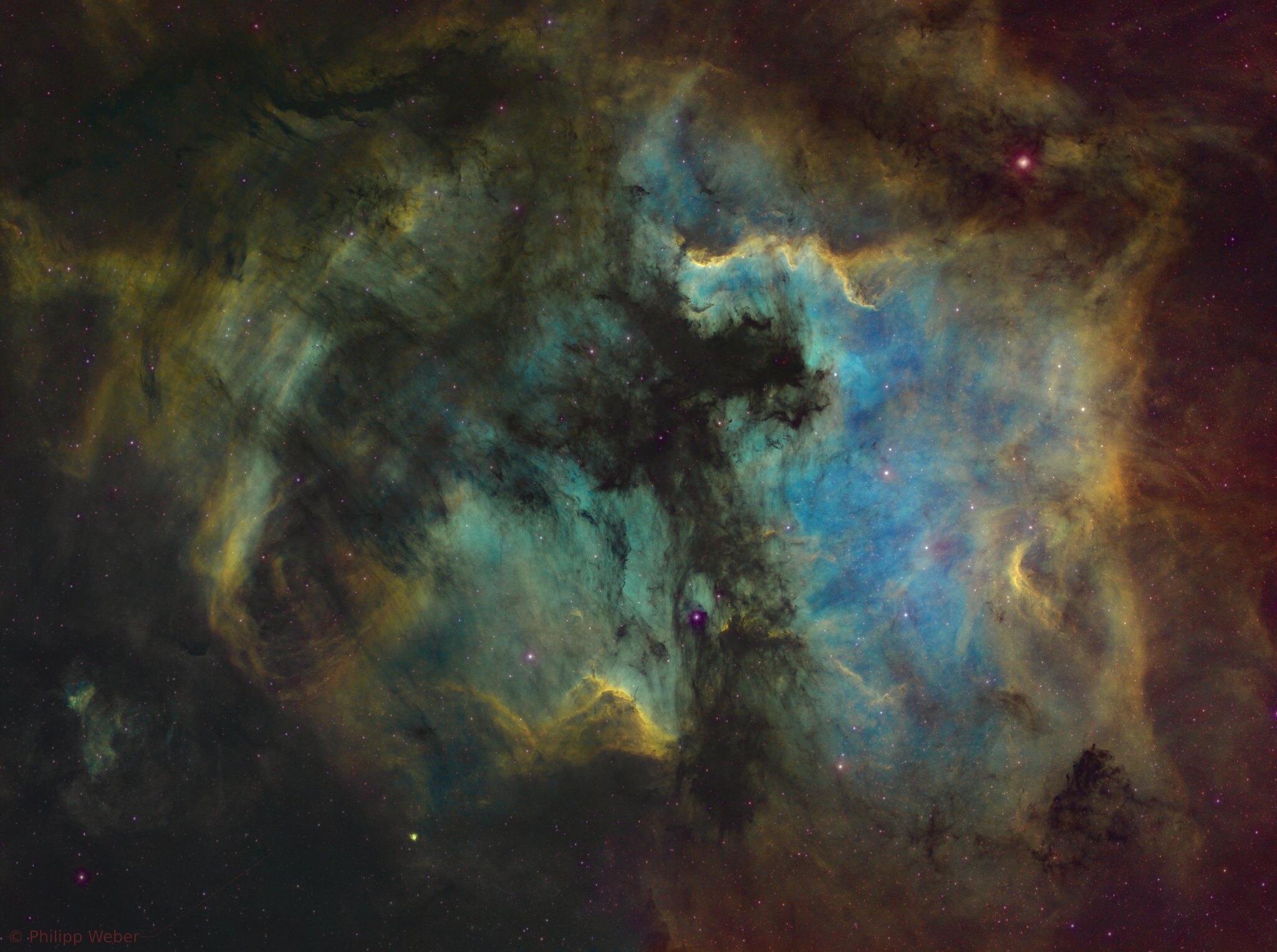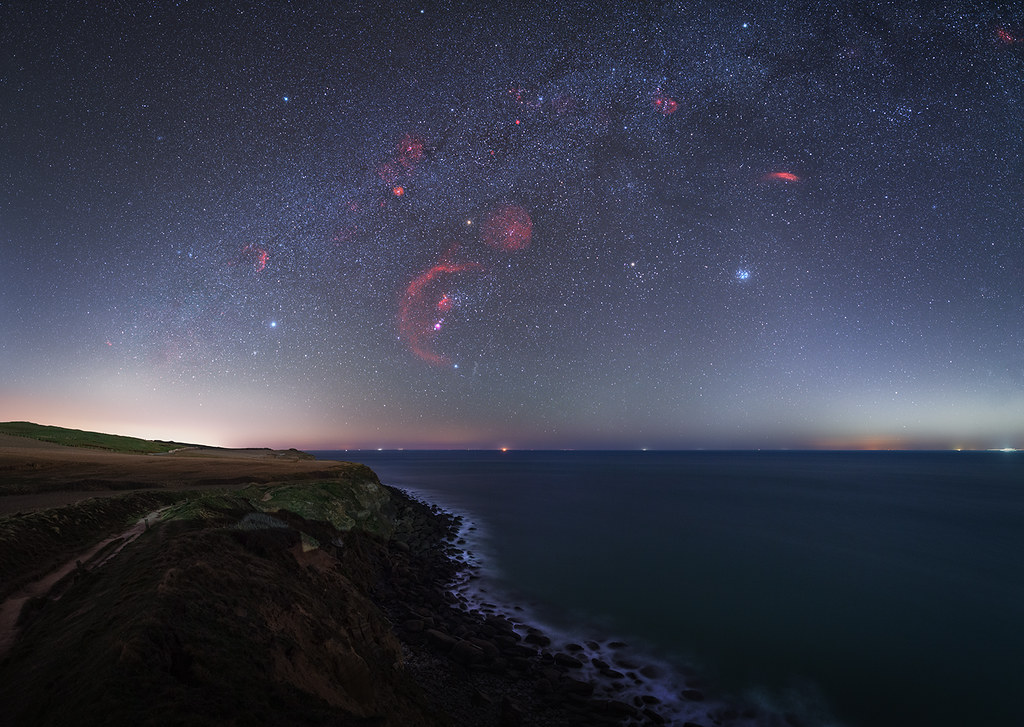Page 3 of 6
Re: Submissions: 2022 March
Posted: Sat Mar 12, 2022 12:25 pm
by Andi1991a
https://live.staticflickr.com/65535/519 ... 51ba_k.jpg
 IFN all around Polaris
IFN all around Polaris by
Andreas Dobbeler, auf Flickr
This is an Image I took at the beginning of March. I took me 3 nights to capture around 800 Pictures each with 60 seconds. I only used 603 of them in the final stack.
Gear used:
Nikon z6
Nikkor 105 1.4 (all Pictures taken at f1.4)
Star Adventurer
Polemaster
i also took 20 - Bias - Lights - Darks and Flatdarks to calibrate my lights.
i stacked the lights in Astro Pixel Processor where I also used the remove light pollution tool.
After that I took the picture in starnet v2 and made a starless version.
I used the starless version to bring out the weak nebulosity as much as possible, I used affinity photo and siril for that.
i also tried to reduce the intensity of the stars in the image with stars in affinity.
after that I merged the pictures together and put the image into topaz Denoise. I only slightly reduced the noise in topaz, to much never looks good.
Re: Submissions: 2022 March
Posted: Sat Mar 12, 2022 2:08 pm
by weber
NGC 7000 & Friends
Details and full quality:
https://www.astrobin.com/8mr2wo/
Re: Submissions: 2022 March
Posted: Sat Mar 12, 2022 6:09 pm
by Michael Tz
My telescope is always watching the ISS.
This is a small collection from recent passes
 https://www.instagram.com/your.daily.astro/
https://www.instagram.com/your.daily.astro/
Re: Submissions: 2022 March
Posted: Sat Mar 12, 2022 9:01 pm
by Altrmind
M81 and Many Others!!
URL of website, if any
Copyright: Michael Armentrout
[img2]file:///C:/Users/Marme/Pictures/Final%20Astro%20Images/fINALishM81.jpg[/img2]
Re: Submissions: 2022 March
Posted: Sat Mar 12, 2022 9:17 pm
by bystander
Altrmind wrote: ↑Sat Mar 12, 2022 9:01 pm
M81 and Many Others!!
URL of website, if any
Copyright: Michael Armentrout
[img2]file:///C:/Users/Marme/Pictures/Final%20Astro%20Images/fINALishM81.jpg[/img2]
You'll either have to upload the file as an attachment, or move it to publicly accessible location. We can't read your local hard drive.
How to post images
Re: Submissions: 2022 March
Posted: Sun Mar 13, 2022 2:26 am
by Altrmike
M81 and many more
URL of website, if any
Copyright: Michael Armentrout
https://www.astrobin.com/full/01c5dc/0/
Re: Submissions: 2022 March
Posted: Sun Mar 13, 2022 2:42 am
by Altrmind
M81 And Many More
URL of website, if any
Copyright: Michael Armentrout
 fINALishM81
fINALishM81 by
Michael Armentrout, on Flickr
Re: Submissions: 2022 March
Posted: Sun Mar 13, 2022 11:59 am
by tinmar_g
 Milky Way in Cévennes countryside
Milky Way in Cévennes countryside by
Martin Giraud
IG :
@timar_g
Hello,
Here is a panorama that I shot in Cévennes in France. I choose this location because of the granite rocks which are interesting foreground for photography. Cévennes is a very retired area with mountains, forests and some great area with nothing called « causses » that looks like Mongolian steppes. The spot was lost in the middle of nowhere juste next to a very little countryside road, in spite of that there had so much cars that takes this road with full headlights… The rocks are located into a field surrounded by barbed wire. The field is used for cows but this night fortunately they weren’t there.
Each tilt is a stack of 6 pictures 30sec ISO-3200 f2.8. For the sky part there are 3 row of 3 tiles. For the foreground it's a row of 3 tiles that has been shot in the blue hour juste before the night with those settings : ISO-1250 | f5.6 | 1/5sec
Equipment :
- Canon 6D Astrodon moddified
- Sigma Art 50mm
- Sywatcher Star Adventurer
Processing :
- For each panel (sky & foreground) stacked on Sequator
- Adjust each panel on Photoshop (curve and Camera raw filter)
- Assemble the panoramo on PTGui - Final adjustments (crop and Camera raw filter) on Photoshop
Re: Submissions: 2022 March
Posted: Sun Mar 13, 2022 12:17 pm
by Iaffaldano Giuseppe Carmine
The center of Virgo Galaxies Cluster:
 Virgo Galaxies Cluster - Old images mixed with new rgb with ASI 071+E180
Virgo Galaxies Cluster - Old images mixed with new rgb with ASI 071+E180
Copyright Dean Salman and Iaffaldano G.C.
Re: Submissions: 2022 March
Posted: Sun Mar 13, 2022 1:04 pm
by Iaffaldano Giuseppe Carmine
Re: Submissions: 2022 March
Posted: Sun Mar 13, 2022 5:57 pm
by lrxphoto
Winter Hexagon between French and English coasts
Website :
www.louisleroux.fr
IG :
@lrx.photo
https://live.staticflickr.com/65535/519 ... d8d4_h.jpg
on
Flickr
Copyright : Louis LEROUX-GERE
Location : Cap Gris Nez, Pas-de-Calais, France
A little project planned for months. Due to the bad weather in the nothern France, I was able to realize this panorama 2 weeks ago. It was really close because the Orion constellation sets earlier and earlier around midnight and the astronomical night start at 9pm.
The light pollution visible on the left is due to a big city. A little further to the right is the light pollution of French cities more than 100km away (orange glow under Orion) ! Finally, on the right, you can see the light pollution of the cities of the English coasts.
You can easily recognize the "winter hexagon" in the middle of the sky. The Milky Way appear in the center of the asterism. A lot of H-Alpha nebulae in our winter night sky are visible.
Equipment :
-Canon 6D Astrodon
-Sigma Art 24mm f/1.4
-Nisi Natural Night filter
-Skywatcher Star Adventurer
EXIF & technic :
Sky : 3 tiles 20x1mn iso 2000 f/2.8
Foreground : 3 tiles (2 focus stacking for each) 5x1mn iso 1600 f/2.8
Tripod didn't move, I just push to "off" my Star Adventurer for the foreground.
Processing :
Pre-process : Pixinsight
Merge : PTgui
Post-process : Photoshop
Clear skies !
Re: Submissions: 2022 March
Posted: Sun Mar 13, 2022 6:11 pm
by Altrmind
 Superfinal
Superfinal by
Michael Armentrout, on Flickr
I am in AWE of the beauty, the scale and the workings in general of the universe. Even though we have measurements of these things in and outside of our galaxy and others in human daily terms it is somewhat unfathomable. We are literally looking into the past as we look at the sky and depending on an estimated age of a star and its distance the objects, we see in the sky may not be there anymore and the only reason we can see them is it takes so long for the light to cease shining as it travels to us. for perspective light travels 186,000 miles in a second that is 7 times around the earth in a second there for light will travel around the earth 220,752,000 times in a year while still unfathomable it might shed some "Light" perspectivaly. the lifespan of a second-generation star give or take is about 11billion years before death as an example our Sun is 5 billion years old and has 5 billion years left to live. in the case of the Orion nebula this is one of the closest active stars forming regions. most of the stars there are estimated to be only about a million years old i say only because of the estimated lifespan of a star which means the stars we see in the Orion nebula are still there just 1,500 years older than we see them. another thing i find real interesting about the nebula photos them selves is that since we are so far away and have the ability to collect light over long periods we have the ability to create beautiful photos within the wavelengths the photons appear to us in. But the dust is so thin in a sense that if we were actually next to or in the nebula itself we would not actually realize we were even in a nebula. Anyway I am blown away by these things and it is almost incomprehensible which blows my mind into a sense of Awe, almost spiritual like. Keep Looking UP!!
Technical Stuff:
By Michael Armentrout
Marana, AZ
Average moon 15%
Seeing Good
Bortle 4
Scope RedCat 71
Guide Scope: William optics 32mm
Mount: GEM45
Main Camera: ZWO ASI 183mm Pro
Guide Camera: ZWO ASI 120mm mini
FilterWheel: ZWO EFW
Filters: ZWO LRGB+H
Processed in PIXINSIGHT
Main Image
L 300s X 78
R 300s X 75
G 300s X 55
B 300s X 40
H 300s X 57
Core
L 30s X 120
R 30s X 120
G 30s X 120
B 30s X 120
H 30s X 120
Re: Submissions: 2022 March
Posted: Sun Mar 13, 2022 8:27 pm
by salvatorecerruto
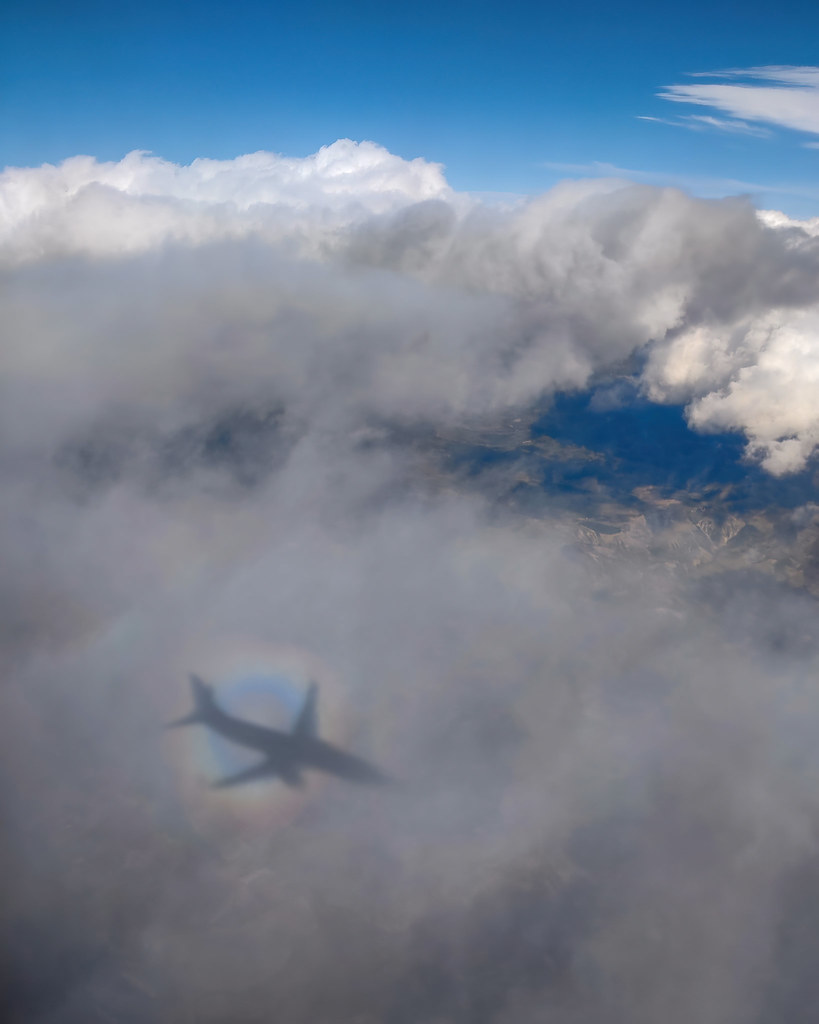 The glory of the pilot
The glory of the pilot by
Salvatore Cerruto, su Flickr
During a recent trip, while landing, I found myself observing "a glory" from the window of the plane on which I was traveling. At that precise moment the plane was over the skies of Sicily and was approaching Catania's Fontanarossa airport. In particular, this type of optical effect takes the name of "pilot's glory" precisely because it can be seen during a flight if it is observed from the side directly opposite the Sun. This phenomenon can sometimes be observed in favorable conditions on mountain tops, and often it can be described as a bright halo surrounding its own shadow. The phenomenon is created thanks to small droplets of water that somehow reflect, refract and diffract sunlight back towards the Sun. The phenomenon has similar counterparts in other branches of science, including astronomy, where looking outside the Earth in the opposite direction to the Sun will achieve this luminous effect. For example, it was also possible to observe this effect from the ISS and astronaut Alexander Gerst was able to photograph it at an altitude of 400 km (
https://www.flickr.com/photos/astro_alex/43932495520/).
https://live.staticflickr.com/65535/519 ... 30e4_o.jpg
Technical data: Oneplus Nord, 35mm, f / 1.7, ISO-125, 1/2000 sec
Shooting coordinates: 37.6771210, 14.6250490 (Sicily)
Date: 2022-03-11
Re: Submissions: 2022 March
Posted: Mon Mar 14, 2022 12:10 am
by wrightdobbs
"ISS Flies Through the Milky Way"
Captured in the Florida Big Bend
The International Space Station flew overhead and through the Milky Way in this scene pictured from the coast of the Florida Big Bend on the morning of March 13. It also flew right near the Rho Ophiuchi cloud complex. The ISS was quite bright on this pass and was about magnitude -3.3. Managed to just get the capture in before the morning twilight began to ruin the details.
Imaging camera was a Sony a7ii, Sigma 14mm f/1.8 lens, Star Adventurer 2i tracker.
https://twitter.com/WrightDobbs
https://www.facebook.com/wrightdobbsphotography
https://instagram.com/wrightdobbs
Re: Submissions: 2022 March
Posted: Mon Mar 14, 2022 12:40 am
by Kinch
A close look in at the Rosette:
Click on above to enlarge.
Full info and high resolution @
https://www.kinchastro.com/rosette-nebula.html
Re: Submissions: 2022 March
Posted: Mon Mar 14, 2022 1:58 am
by jbohanon
NGC 3324, Gabriela Mistral Nebula.
Data set from Deep Sky West in Chile (processed by me).
Details:
Telescope: TOA 150
Camera: FLI ML16200
Filters:
R = 600 x 22
G = 600 x 24
B = 600 x 18
S = 1800 x 14
H = 1800 x 14
O = 1800 x 15
Full size image here:
http://www.joebohanon.com/wordpress/wp- ... C-3324.jpg
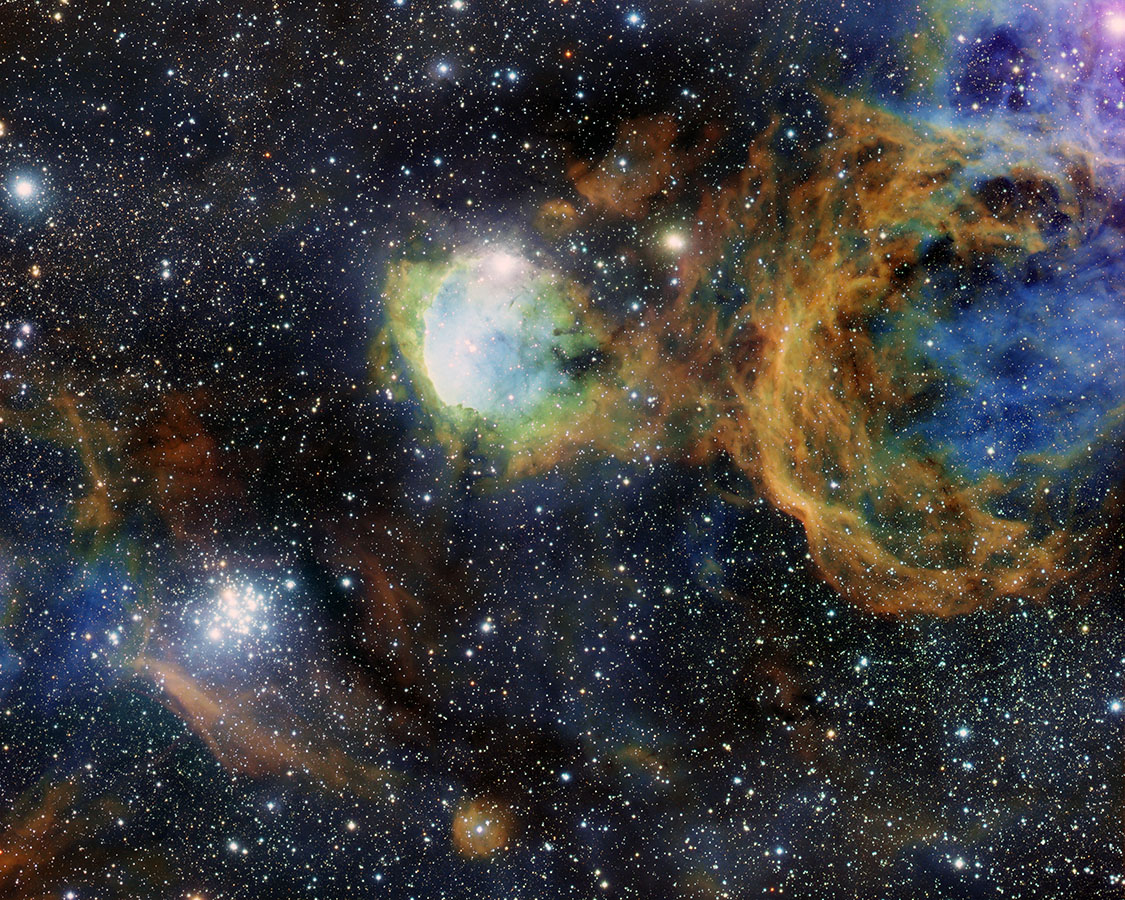
Re: Submissions: 2022 March
Posted: Mon Mar 14, 2022 12:06 pm
by Mathieu80
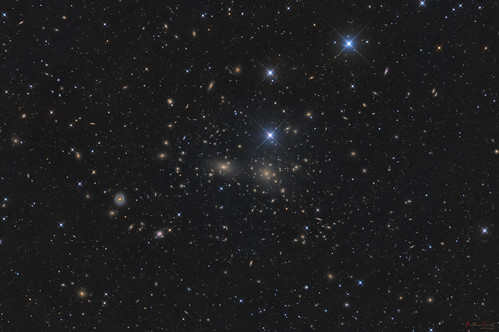 Abell1656 The Coma Cluster
Abell1656 The Coma Cluster by
Mathieu Guinot, sur Flickr
The fantastic Coma Cluster (Abell 56) located 330 millions light-years away in Coma Berenice contains over 1000 identified galaxies. Along with the Leo Cluster (Abell 1367), it is one of the two major clusters comprising the Coma Supercluster.
The central region is dominated by two supergiant elliptical galaxies : NGC4874 and NGC4889, and as is usual for clusters of this richness, the galaxies are overwhelmingly elliptical, with only a few spirals of younger age near the outskirts of the cluster.
I wanted to capture this object for a long time and I'm glad I could do it from my downtown Bortle 6-7 sky.
Newton 250mm f/4 on IOPTRON CEM70 mount
Camera ZWO ASI2600mm + Antlia LRGB filters
23h50 exposures in February and March 2022 from my backyard.
L : 232 x 300s
RGB : each 18x300s
Processed with Pixinsight and Photoshop
Re: Submissions: 2022 March
Posted: Mon Mar 14, 2022 6:54 pm
by asro8042
A Heart in Monoceros
Copyright: Jon Talbot, Marcel Drechsler
I'm excited to announce the first deep image taken of the potential planetary nebula Strottner-Drechsler 44 (StDr44) in the constellation Monoceros. StDr44 was discovered by Xavier Strottner and Marcel Drechsler in March of 2020. It lies not too far from the frequently imaged Sea Gull Nebula. StDr44 is the object near image center. This fascinating object takes on the shape of a heart so I thought appropriate to give the name of "The Heart in Monoceros". I collected the data duing Late Nov 21 into mid Jan 22. The data was sent to the Strottner/Drechsler team and the image above was expertly processed by Marcel Drechsler, one of the co discoverer's.
StDr 44 is very faint but shows emission in Ha and OIII bands. It's approximately 21x13 arcmin in diameter. Hopefully, in the future, this image will allow for professional spectra to be taken of this object unveiling its true nature.
Within the full image is a large area of Ha emission and several other objects.
On the lower right lies another "likely" planetary nebula with the designation PHR J0701-0749. It's much smaller and looks like a typical oval shell of gas that has been ejected from the host star. It also shows a fan shaped area of Ha emission which is brighter to its north. Near the center top of the image is the reflection nebula GN 07.00..7.
Full resolution and other image details here:
http://www.starscapeimaging.com/StDr44/StDr44.html
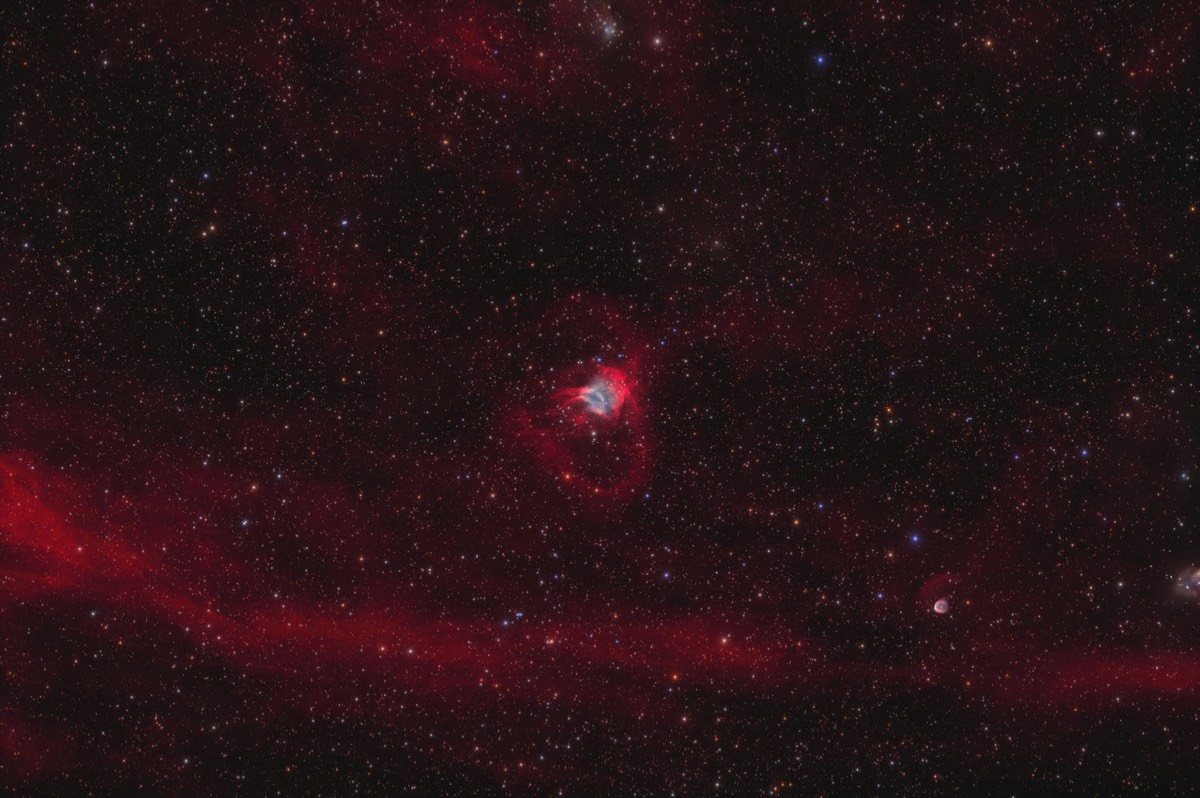
Halo Solar
Posted: Mon Mar 14, 2022 7:01 pm
by alcarreño
Copyrights: Raul Villaverde Fraile
Canon 6D
Sigma Art 14mm
Iso 100
Exp.: 1/800
f/5.6
 Halo solar 14mm
Halo solar 14mm by
R Villaverde, en Flickr
Re: Submissions: 2022 March
Posted: Tue Mar 15, 2022 2:38 am
by ImNewHere
This was something interesting to notice, a pattern that looks like a bubble or a ring in NGC 104. I've processed it before and never noticed it, but now that I see it I have checked multiple images and I still see it. Maybe you'll agree that it looks pretty cool and makes an interesting target even more interesting.
Data captured through Telescope Live using an ASA 500N, FLI PL16083, and Astrodon RGB filters, with 7x R, 6x G, and 7x B at 180 seconds each. I processed it in Astro Pixel Processor and Photoshop 2022.
I bet now that you've noticed it you will have your eye drawn to it every single time you see this object! You can no longer unsee it!
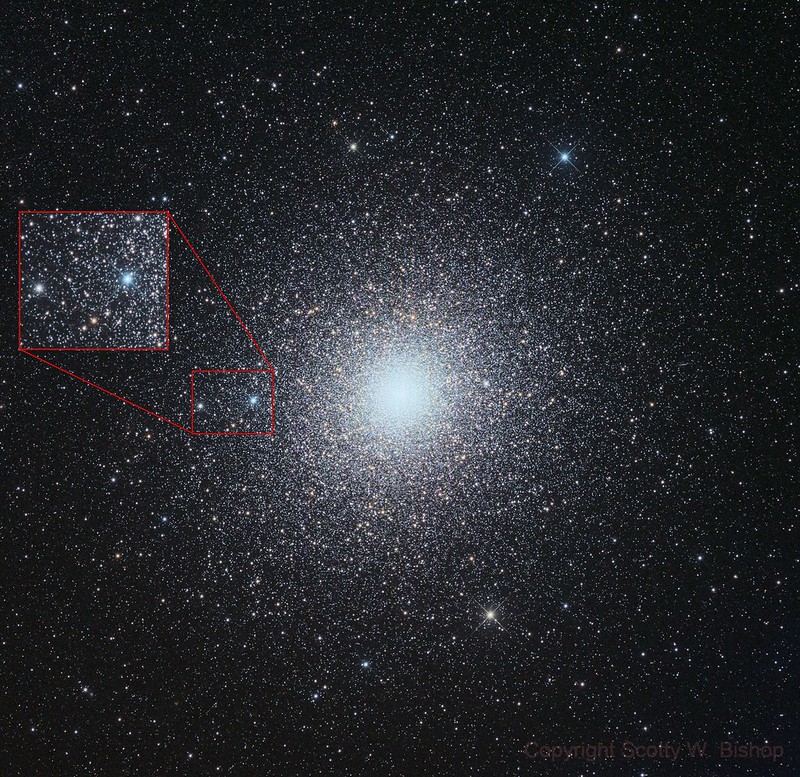 NGC_104_Bubble
NGC_104_Bubble by
Scotty Bishop, on Flickr
Re: Submissions: 2022 March
Posted: Tue Mar 15, 2022 9:16 am
by Ann
ImNewHere wrote: ↑Tue Mar 15, 2022 2:38 am
This was something interesting to notice, a pattern that looks like a bubble or a ring in NGC 104. I've processed it before and never noticed it, but now that I see it I have checked multiple images and I still see it. Maybe you'll agree that it looks pretty cool and makes an interesting target even more interesting.
Data captured through Telescope Live using an ASA 500N, FLI PL16083, and Astrodon RGB filters, with 7x R, 6x G, and 7x B at 180 seconds each. I processed it in Astro Pixel Processor and Photoshop 2022.
I bet now that you've noticed it you will have your eye drawn to it every single time you see this object! You can no longer unsee it!
 NGC_104_Bubble
NGC_104_Bubble by
Scotty Bishop, on Flickr
You're right. The bubble is visible in the
APOD of March 10, 2022, which featured 47 Tuc (NGC 104):
I wonder if diffraction spikes from the foreground star to the right of this amazing asterism helps create the illusion of a bubble.
Ann
Re: Submissions: 2022 March
Posted: Tue Mar 15, 2022 11:41 am
by moonrocks
Re: Submissions: 2022 March
Posted: Tue Mar 15, 2022 1:11 pm
by ImNewHere
Ann wrote: ↑Tue Mar 15, 2022 9:16 am
ImNewHere wrote: ↑Tue Mar 15, 2022 2:38 am
This was something interesting to notice, a pattern that looks like a bubble or a ring in NGC 104. I've processed it before and never noticed it, but now that I see it I have checked multiple images and I still see it. Maybe you'll agree that it looks pretty cool and makes an interesting target even more interesting.
Data captured through Telescope Live using an ASA 500N, FLI PL16083, and Astrodon RGB filters, with 7x R, 6x G, and 7x B at 180 seconds each. I processed it in Astro Pixel Processor and Photoshop 2022.
I bet now that you've noticed it you will have your eye drawn to it every single time you see this object! You can no longer unsee it!
 NGC_104_Bubble
NGC_104_Bubble by
Scotty Bishop, on Flickr
You're right. The bubble is visible in the
APOD of March 10, 2022, which featured 47 Tuc (NGC 104):
Bubble in 47 Tuc detail from APOD March 10 2022.png
I wonder if diffraction spikes from the foreground star to the right of this amazing asterism helps create the illusion of a bubble.
Ann
I hope if no one else has noticed or named it then it gets named Scotty's Bubble.
I looked through Sesame, wikisky.org, all over Astrobin, and even through Google and I found it odd that I couldn't find it and that no one has mentioned it. While I have serious doubts that it would be a "new" discovery I thought it would be pretty cool to point it out.
Re: Submissions: 2022 March
Posted: Tue Mar 15, 2022 3:24 pm
by Lighty
Moon and Venus met under the heart of the Milky Way in Chile
Copyright : Maxime Oudoux
https://maximeoudouxphotographie.fr
Here, in Chile, the central bulge of our galaxy rises at the end of the night almost vertically. We can observe all the dark structures (interstellar gas and dust) that travel through our galaxy for hundreds of light years. Some red nebulae also stand out, but the whole remains "discreet" in the face of the power of the light of the Moon.
It illuminated a desolate, desert, even "Martian" ground where only a few cacti and a few small shrubs manage to survive in this dry climate and scorched by the sun during the day. The floor, almost monochromatic, took on a rather surprising "caramel" color.
To the left of the Moon, Venus was also shining brightly. As it rose behind the mountain in the distance, its brilliance appeared suddenly, like an explosion at the top.
On the horizon, the sky was filled with airglow (natural phenomenon of chemiluminescence in the upper layers of the atmosphere), which gives this cyan / green hue.
On the processing side, this image was not easy to handle. The moon produces a powerful gradient in the sky that must be mastered... the colors are also difficult to work with without disfiguring everything.
The rendering here is quite neutral because the image appears in my series "The Colors of the Night" where the work of reproducing the nocturnal atmosphere - while bringing aesthetics - is important and respected.
Only 8s of exposure time for the whole image: no stacking or several different exposure times.
Nikon D750 Astrodon
Samyang 35mm f/1.4 AS UMC
Panoramic head Nodal Ninja VI RD-16
Benro Tripod
Panoramic of 35 images
All the images were taken in the same place, at the same time, with the same settings
8s, 35mm, ISO4000, f/2.8
Processing, assembly and retouching on DxO Photolab 5, AutoPano Giga 4.4.2, Photoshop CC 2022
Re: Submissions: 2022 March
Posted: Wed Mar 16, 2022 3:14 pm
by the_astronomy_enthusiast
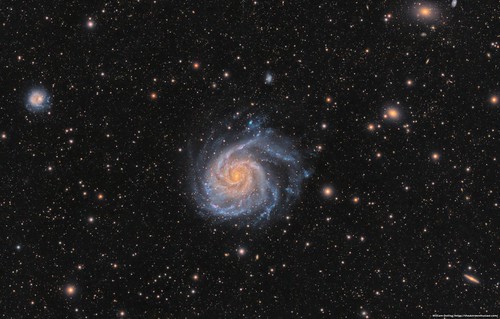 A luminous M101 with outer spiral arms
A luminous M101 with outer spiral arms by
William Ostling, on Flickr
Full write up here:
https://theastroenthusiast.com/a-lumino ... iral-arms/
Big, beautiful spiral galaxy M101 is one of the last entries in Charles Messier’s famous catalog, but definitely not one of the least. About 170,000 light-years across, this galaxy is enormous, almost twice the size of our own Milky Way galaxy. M101 was also one of the original spiral nebulae observed by Lord Rosse’s large 19th century telescope, the Leviathan of Parsontown. M101 shares this modern telescopic field of view with more distant background galaxies, foreground stars within the Milky Way, and a companion dwarf galaxy NGC 5474 (upper left). The colors of the Milky Way stars can also be found in the starlight from the large island universe. Its core is dominated by light from cool yellowish stars. Along its grand design spiral arms are the blue colors of hotter, young stars mixed with obscuring dust lanes and pinkish star forming regions. Also known as the Pinwheel Galaxy, M101 lies within the boundaries of the northern constellation Ursa Major, about 23 million light-years away. Its companion NGC 5474 has likely been distorted by its past gravitational interactions with the dominant M101.
I chose to dump a lot of integration time with longer subframes (28 hours worth of 3 minute frames) to try to reveal some of the fainter outer arms not shown in most astrographs. I think I succeeded quite well – you can see the three fainter arms take shape on the left side of the galaxy. Compared to my last image of M101, this is quite the improvement!
Website:
https://theastroenthusiast.com/
Instagram:
https://www.instagram.com/the_astronomy_enthusiast/


